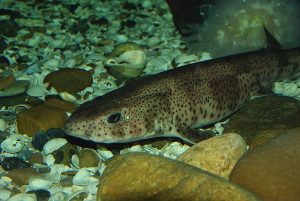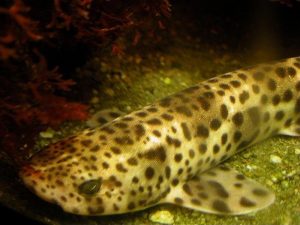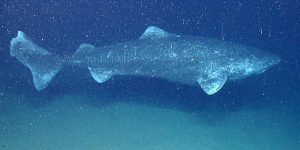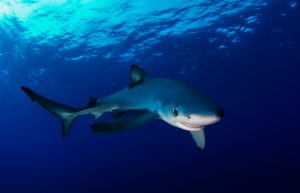We do too. But do you want to go out and see them?
Show me Wild ExperiencesKeep up to date with the hottest wildlife content on the web and save £10 on your first wildlife experience.
Sign Me Up!With the amount of globally recognised shark species seemingly increasing every year, it is now thought there are around 500 species worldwide. And of these 500 species, around 40 are British shark species.
Okay, so by “British sharks” we mean those that are found in UK waters at least some of the time.
I’m pretty sure you’ll be surprised by some of these. - Especially #3.
So without further ado, here are 10 British shark species and where you can go to find them.

Common names: Lesser Spotted Catshark, Common Dogfish, Sandy Dogfish, Lesser-Spotted Dogfish, Rough-Hound or Morgay by Ecomare/Sytske Dijksen via Wikimedia Commons
Also known as the Common Dogfish (a bit counter-intuitive if you ask me). This shark is a common species found in most coastal areas, often close to shore. It’s often overlooked because of its small size.
You can expect to the see them on most diving trips in the UK. They can also be seen whilst snorkelling above rocky sediments where they often lie on the seabed.
You can easily find their egg cases too on most beaches. The Shark Trust is running The Great Egg Case Hunt that teaches you how to find and identify them.

Common names: Greater Spotted Catshark, Large-Spotted Dogfish, Nursehound or Bull Huss by Petra Karstedt via Wikimedia Commons
When studying for a degree in any animal science, you’re taught never to describe an animal by its size. That’s because you don’t know how mature the animal is. And so relative to other species it can be a poor giveaway.
But, I’m going to be a bit naughty and do exactly this.
I mean, seriously I have too, just look at the name. It’s essentially a beefed up version of the Lesser-Spotted Catshark.
As far as British shark species go, this species isn’t particularly rare. It can be seen in similar habitats to that of the Lesser-Spotted Catshark. Inshore waters, not too deep, on rocky surfaces and in small holes and crevices.

Common names: Greenland Shark, Sleeper Shark, Large Sleeper Shark, Ground Shark, Gray Shark or Gurry Shark by NOAA Okeanos Explorer Program via Wikimedia Commons
An absolutely magnificent animal. Only a few people know that it can be found in UK waters.
It’s a larger shark being able to grow more than 6.4 meters in length. And is thought to be able to live for more than 100 years. Other than some key facts, it’s a poorly understood species.
It’s primarily distributed in the Arctic regions but can also stray into waters north of Scotland and sometimes the east coast of England. They’re a deepwater species too, often living more than 1,000 below the surface.
If you want to see one in the wild, I hate to say, it won’t be easy for recreational purposes. Especially in the UK. Trips in other parts of the world make seeing them possible. Though they are few and far between.
As I write this, I’m finding myself nerding out about this shark. I would love to make a separate post all about it. Let me know in the comments if it would interest you.

Common names: Blue Shark, Blue Dog or Blue Whaler
I have something of an unhealthy infatuation with this shark. I adore it.
It’s highly migratory, being able to cross entire oceans and it loves the open sea. A bit of a free spirit really. You can learn more about it here.
But perhaps one of the reasons I love it so much is because it’s an awesome predator. And it be found in our seas.
They love the open ocean but can be found about 20 miles off the coast of Cornwall from May-October.
We actually know this because we have a 3-night holiday itinerary for you to actually get up close and swim with them. Check out Cornwall’s Basking & Blue Sharks to find out more.

Common names: Shortfin Mako Shark, Mako, Short-finned Mako, Blue
Pointer, Mackerel Shark or Blue Dynamite by Mark Conlin, SWFSC Large Pelagics Program via Wikimedia Commons
Like the Blue Shark, the Mako Shark is another awesome predator. It’s often regarded as the fastest shark species. Though some claim that title belongs to its relative, the Salmon Shark.
It is also a very close relation to the Great White Shark. Just think of it as a mini torpedo version.
In case you’ve ever wondered why the UK doesn’t have any Great Whites, you can read our blog post that presents some theories.
Like the Blue Shark, it is an open-water species that’s highly migratory. Unlike the Blue Shark however, it can take down fast-swimming prey like tuna. In case you didn’t know, some tuna species can swim at 47 mph. That’s pretty fast.

Common names: Thresher Shark, Common Thresher, Thintail Thresher, Fox Shark, Sea Fox, Swiveltail or Thrasher by Thomas Alexander via Wikimedia Commons
An easily recognisable British shark. The Thresher possesses a distinctive long tail that is used to slap and stun fish.
Threshers are the only sharks that are able to do this and are incredibly successful doing so. It takes a lot less energy to slap its tail than having to swim as fast as it can to catch the fish.
They are open water species like many others on this list. They’re found all around the UK in deep water where depths exceed 300 meters.

Basking Shark, Bone Shark, Elephant Shark or Hoe-Mother
A very popular visitor when it strays into UK waters. The Basking Shark is something of a national celebrity when they start to arrive in May. Even though the national press like to go hysterical claiming them to be Great Whites.
They’re brought in as the plankton aggregating on the sea floor is pushed to the surface in a process called upwelling.
Unlike most of the other sharks on this list, this one is relatively easy to see.
You don’t need to go and swim deep since they practically live at the surface. And if you don’t fancy getting wet to see them, you don’t have to. You can sit from a boat and watch them as they glide by.
Our Basking & Blue Sharks Break is an ideal itinerary for you to get up close with these magnificent animals.

Bluntnose Sixgill Shark, Atlantic Mud Shark, Brown Shark, Bull Dog Shark, Bull Shark, Cow Shark, Gray Shark, Mud Shark or Sixgill Cow Shark by NOAA Ocean Explorer via Wikimedia Commons
A rare and elusive species that’s found almost exclusively in deep water, sometimes up to 2,000m below the surface.
As with many deepwater species. It is poorly understood and there is plenty of research needed to learn more about them.
You may have guessed, judging from the name, that they can be identified by an extra gill slit. They are also a large and stocky species. In fact, their total length is able to reach 4.8 meters for some females.
I’m sorry to disappoint you again. But if you were looking to jump in the sea and go in search for them, you’re out of luck. At least in the UK.
There are plenty of opportunities for recreational divers to get up close with them in the Pacific Ocean. Just not in Britain’s part of the Atlantic.

Common names: Porbeagle Shark, Atlantic Mackerel Shark, Bottle-nosed Shark or Beaumaris Shark
A close relative to the Mako Shark and the Great White Shark.
The Porbeagle is smaller than the two but shares the many of the same characteristics.
It’s also relatively common. There are countless boat charters across the UK that are experienced in angling them.
They love the open ocean and you’d be lucky to see one off your local beach.

Common names: Tope, School Shark, Soupfin Shark, Flake, Greyshark, Penny’s Dog, Schnapper Shark, Sharpie Shark, Sweet William Shark or Vitamin Shark by Ross Robertson via eol.org
Our final British shark that’s often forgotten is the Tope.
It’s a slender species, that doesn’t get too large. They’re a common catch amongst sea anglers, though they are usually released back into the sea.
You can find them throughout the UK with relative ease since they don’t live too deep and they tend to stay in the middle of the water column.
They also like the cold water and make annual migrations to the polar regions during summer.
I hope you found out something new by reading this post.
To many people (myself included when I was young) think a British shark is something that we don’t really get off the UK.
But, now you know that not only do we have a wide variety of species in our seas. But we also have some mightly impressive ones that could give Jaws a run for their money.
Which are your favourite species on this list?
Let me know down in the comments. I read and reply to everyone, so don’t be shy.